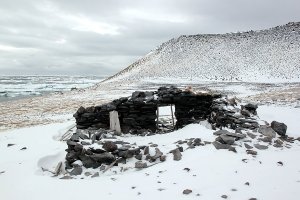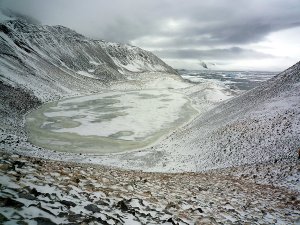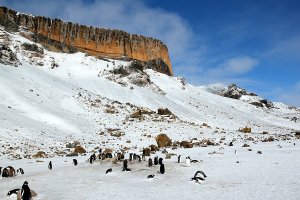Arto's Blog
| « Towards South Georgia: Seasickness hits again | Sunny whale watching on the Weddell Sea » |
The end of the Antarctic summer
Posted: 2015-08-03 00:41:00, Categories: Travel, Argentina, Antarctica, Sailing, 673 words (permalink)It was almost mid March and the short and busy summer season in
Antarctica was coming to its end. Most of the animals had already
raised their offspring and left towards warmer regions. During our
last two days near the Antarctic Peninsula we could feel the autumn,
both in the quietness of the nature as in the changing weather.
We landed on the small Paulet Island, still following the route of
the Nordenskjöld expedition (also known as the Swedish Antarctic
Expedition) 1901-1904. It was the first time in four years that the
Bark Europa was able to do a landing there, having tried once every
year. The snow at our landing site was coloured pink, from the guano
of about a hundred thousand Adelie penguins which had nested there
during the summer. Now they were almost all gone, with only a few
penguins and other birds, some frozen carcasses and the smell left
behind.
We saw the basic stone hut which had been built by the members of
the Nordenskjöld expedition in 1903 after their ship sank next to
the island. It was quite amazing to think how they survived the
harsh winter inside that small pile of rocks almost without
supplies. We climbed up the hill, which opened us a view over the
shore and a small freshwater lake. The lake was already frozen and
the ice was yellow in color, due to a rather large concentration of
penguin pee.
From Paulet Island we motored a short distance to Petrel Cove on
the Dundee Island, named after the Argentine station
"Petrel". The station consisted of bright red buildings
just like Esperanza we had visited a few days earlier, but it was
smaller and there weren't any people around. We heard that the
station had been mostly unmanned already for many years. Once in a
while some research is conducted or at least craftsmen are sent to
do maintenance on the buildings.
We walked a bit around and between the buildings and headed then
for a short walk on top of the snow covered glacier next to the
base. During the walk the wind started picking up and quite soon we
found ourselves inside a small snow storm. We joked about being on a
honeymoon in such a cold, windy and desolate place, and asked our
Swedish friend Micke to take a photo of us. After that we walked
back to the shore and were transported to the ship as usual in the
zodiacs, zig-zagging between blocks of ice floating in the sea.
Early following morning we sailed west to Brown Bluff for our last
landing on the Antarctic Peninsula. The snowfall had stopped, wind
had calmed down, and shortly after landing even the sun came out.
Yippee, finally a landing with sunshine! At Brown Bluff there were
still quite a few penguins and seals around, and there were also
interesting geological formations to see. A massive brown and black
coloured mountain dominated the landscape, and walking closer to it
revealed various volcanic features such as pillow lava rocks lying
on the ground and black stones embedded inside a brown wall.
Right next to the volcanic rocks a glacier was reaching out to the
sea. The 20-30 meter high wall of ice at the waterfront and blocks
of ice scattered on the beach looked spectacular in the sunlight. We
got some of our best penguin photos just before boarding the zodiacs
— the sun simply made everything look shinier and friendlier.
We would have loved to stay longer, but the sunny landing at Brown Bluff was a wonderful goodbye to Antarctica. After lunch we raised the anchor and started first motoring and then sailing north-east towards South Georgia, a subantarctic island about 800 nautical miles away.
No feedback yet

Copyright Arto Teräs <ajt@iki.fi>, licensed under the Creative Commons Attribution-Share Alike 3.0 Unported License. (Unless otherwise mentioned in individual photos or other content.)






